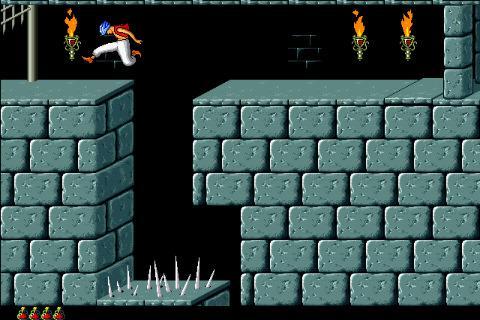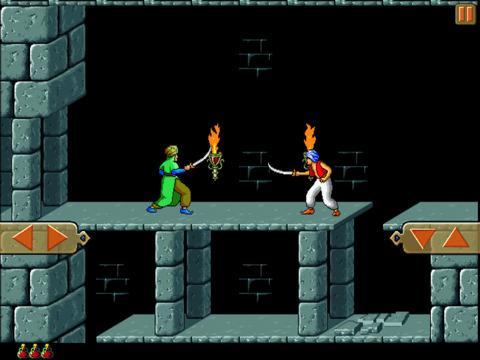- Wondering how to get Monopoly GO! free rolls? Well, you’ve come to the right place. In this guide, we provide you with a bunch of tips and tricks to get some free rolls for the hit new mobile game. We’ll …
Best Roblox Horror Games to Play Right Now – Updated Weekly
By Adele Wilson
Our Best Roblox Horror Games guide features the scariest and most creative experiences to play right now on the platform!The BEST Roblox Games of The Week – Games You Need To Play!
By Sho Roberts
Our feature shares our pick for the Best Roblox Games of the week! With our feature, we guarantee you'll find something new to play!All Grades in Type Soul – Each Race Explained
By Adele Wilson
Our All Grades in Type Soul guide lists every grade in the game for all races, including how to increase your grade quickly!
Prince of Persia Retro Review
Prince of Persia Retro is a perfect port of Jordan Mechner’s classic Prince of Persia, and an easy addition to your app library. The game’s two-dimensional sights and sounds are a tight fit for the iPhone’s small screen. Its combo of platforming, exploration, swordfighting, and high drama are just as addictive as they used to be. Even the touch controls are right on, and arguably feel more intuitive than the keyboard buttons we used in the ’80s. But it’s also perfect to a (slight, but nagging) fault.

18 years since it’s original release, Prince of Persia still manages to impress
Prince of Persia Retro is a perfect port of Jordan Mechner’s classic Prince of Persia, and an easy addition to your app library. The game’s two-dimensional sights and sounds are a tight fit for the iPhone’s small screen. Its combo of platforming, exploration, swordfighting, and high drama are just as addictive as they used to be. Even the touch controls are right on, and arguably feel more intuitive than the keyboard buttons we used in the ’80s. But it’s also perfect to a (slight, but nagging) fault.
As the timeless story goes, the evil vizier Jaffar has imprisoned the Sultan of Persia’s daughter in his tower. He gives her an hour, marked by an hourglass, to consummate his love—or she will die. Meanwhile, the Prince who loves her has been thrown into the dungeon. You have to guide the Prince back up from the depths to rescue the Princess before it’s too late.
When you start out, you’re unarmed and lost. Surrounded by little more than stones and bones, you poke your way around until you find a sword left behind by another prisoner. With the sword, you can battle the guards that populate the dungeons. And when you aren’t fighting, you are running over crumbling platforms, leaping over perilous chasms and beds of spikes, tumbling below metal gates before they shut, and basically trying to find the path to the exit door which leads to the next maze of dangers.

The ingredients are simple, but they are used to their absolute fullest. The environments of Prince of Persia force you to think before you react. If you want to make a long jump, you need to get up to a running start. Run through the dungeons recklessly and you might fall to your death, or close the very gate you were trying to open. Charge too far ahead and you’ll find yourself impaled on spikes that shot out of the floor. Because danger is literally at every step and around every corner, you have to pay close attention to visual details and sound cues to survive and get on the right path.
The new controls don’t hinder the game at all, in large part to how Prince of Persia was originally designed. Though you’ll definitely need fast fingers for certain tricky jumps and battles, this isn’t a twitch game. The game gives you plenty of leeway to use the four virtual buttons (left, right, jump, crouch) along the bottom of the screen without cramping your hands or getting your fingers tangled. Tapping elsewhere on the screen lets the Prince perform a context-sensitive action, such as picking up a potion, swinging his sword, or—crucially—grabbing hold of a ledge as he is jumping or falling.
It’s a pleasure to guide the Prince through the dungeons because they are so vividly realized. Even more than 10 years after the game debuted, the level designs feel smart and beguiling. There are multiple paths, hidden rewards, lonely crevices, and clever puzzles. Numerous little details flesh out the world—unstable floorings tremble under your feet; clashing swords clang loudly; the Prince takes a moment to recover after a long fall. The designer plays psychological games with you, offering side-by-side a potion that heals and a potion that hurts you. Not even the swordfights are mindless, as they require precise timing and careful movements.

It only helps that the iPhone interface eliminates what barrier was left between you and the game world. But the game can’t hide its age in one way. There is no saving, and if you make an ill-timed jump or let your guard down against a final enemy, you’re thrown back to the beginning of the level. While the game grants you the option to start or restart from any of its13 levels, you won’t keep the health bonuses that you pick up during play if you skip around. It’s quite difficult to make it through some of the later levels with your initial health of three units. This means that if you really want to complete the game, you’ll have to keep at it from the beginning (or at least Level 2, which has the first health bonus) and replay the levels in sequence until you’re done. If you exit the game, you’ll lose your progress.
This isn’t a design flaw, since Prince of Persia is deep and addictive enough to warrant replaying its levels until you nail every jump and swordfight. It’s just not an ideal fit for the short bursts of gameplay encouraged by the iPhone. Still, with such a pitch-perfect transition onto the small screen, anyone who is interested in early cinematic adventures—not to mention great videogames—should keep a copy of this classic in their pocket.

The good

The bad
More articles...
Monopoly GO! Free Rolls – Links For Free Dice
By Glen Fox
Wondering how to get Monopoly GO! free rolls? Well, you’ve come to the right place. In this guide, we provide you with a bunch of tips and tricks to get some free rolls for the hit new mobile game. We’ll …Best Roblox Horror Games to Play Right Now – Updated Weekly
By Adele Wilson
Our Best Roblox Horror Games guide features the scariest and most creative experiences to play right now on the platform!The BEST Roblox Games of The Week – Games You Need To Play!
By Sho Roberts
Our feature shares our pick for the Best Roblox Games of the week! With our feature, we guarantee you'll find something new to play!All Grades in Type Soul – Each Race Explained
By Adele Wilson
Our All Grades in Type Soul guide lists every grade in the game for all races, including how to increase your grade quickly!







